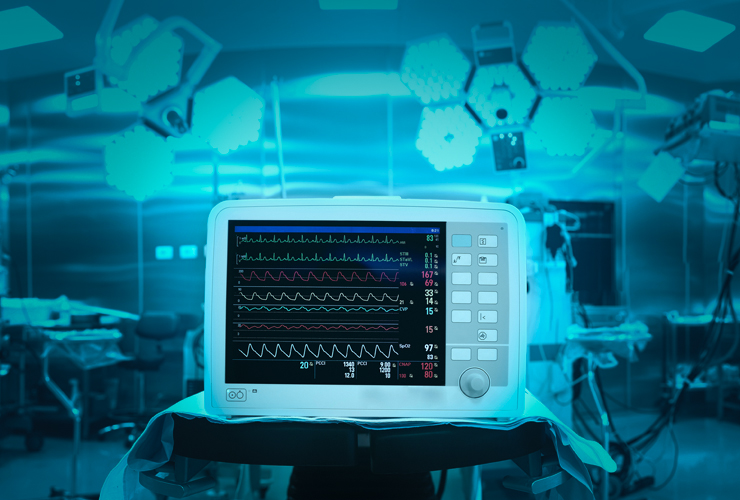
By Andrew Ross and Dan Kephart, Senior Product Managers at Laird Connectivity
A Game Changer for Wireless Clinical Devices: The Impact of Wi-Fi 6/6E on Connected Medical Devices in Hospital Settings
Wi-Fi networks are the indispensable backbone for connected medical devices in hospitals. Because of its performance, reliability, flexibility, security, and other advantages, Wi-Fi has become the dominant connectivity technology for clinical devices such as pulse-ox sensors, infusion pumps, patient monitors, defibrillators, ventilators, beds, and more. Wi-Fi has proven to be ideal for the needs of these devices in medical environments, however the increasing density of wireless medical devices puts tremendous pressure on Wi-Fi networks, as more and more devices require an ever-growing volume of connections and bandwidth.
As the number of Wi-Fi connected devices increases in hospitals, Wi-Fi networks can become overwhelmed not only by the number of devices making demands on the network but also the RF complexity of so many networks and devices operating in close proximity to one another. The solution to these challenges is a new version of Wi-Fi that has been released by the IEEE standards body and labeled Wi-Fi 6 and 6E by the Wi-Fi Alliance. Wi-Fi 6/6E delivers significant advancements and will have an enormous impact on connected device networks in clinical environments. Simply put, this new version of Wi-Fi is a gamechanger for hospitals because it will enable Wi-Fi to continue serving as the backbone of hospital connectivity, even as device density increases and as new devices put greater demands on networks. The advancements in Wi-Fi 6 and 6E are significant:
- Dramatic increases in performance
- Far lower latency
- Wider operational spectrum for devices to utilize
- Extended battery life for mobile devices
- Higher device density through increased concurrent communications
- Lower network-to-network interference
- And other technical advancements that support new applications
The benefits we discuss will only be realized once the infrastructure to support Wi-Fi 6/6E is in place and operational in healthcare environments. Organizations do not necessarily have to take full advantage of every single feature in Wi-Fi 6/6E in order to see major improvements in performance, latency, and more, but the 6/6E infrastructure does need to be in place as a foundation. That is on the horizon, but product engineers should begin planning for the Wi-Fi 6/6E era now in order to deliver the next generation of clinical devices that take advantage of the following features and benefits:
- Multi-User Multiple-In Multiple-Out (MU-MIMO): enables Wi-Fi gateways to create spatial streams that focus RF activity in the physical direction of each device in their domain.
- Orthogonal Frequency Division Multiple-Access (OFDMA): uses different subchannels to allow more devices to send and receive data simultaneously in non-interfering subchannel spaces.
- BSS Coloring (Basic Service Set Coloring): intelligently organizes network traffic in areas where multiple gateways are overlapping by adding a prepend to their broadcast identifier in the form of a color. If a device hears a broadcast on its channel, but the broadcast is of a different color, the device can determine that it’s for another service set and go ahead and broadcast without waiting
- Faster Data throughput: Increases to 9.6 Gbps from Wi-Fi 5’s rate of 3.5 Gbps, roughly a 3x increase in data throughput, but the real-world increase in throughput is much higher when that faster architecture is combined with MU-MIMO, OFDMA and BSS Coloring.
- Enhanced Device Roaming: Wi-Fi 6/6e manages roaming devices far more effectively and efficiently through the use of features in 802.11r, 802.11k and 802.11v that manage those connections in automated ways that optimize connectivity for a given device.
- Bolstered Security: WPA3-Enterprise 192-bit security in all bands, allowing clinical devices to operate on more secure connections than the open, unencrypted WLANs that prior versions of Wi-Fi employed.
- 6GHz Spectrum: Over 1 GHz of additional spectrum available in the 6 GHz band.
- Energy Efficiency: Target Wake Time (TWT) technology enables much longer sleep times for clients that preserve battery through extended inactivity while still remaining connected to the network.
Other Advantages of Wi-Fi 6/6E
In addition to the benefits discussed above, Wi-Fi 6/6E has a number of other advantages for hospitals, including data integrity, which is a critical issue given the mobility of so many medical devices. The enhanced connectivity that Wi-Fi 6/6E delivers ensures that there is no loss of data as a patient or device moves through a hospital. Another advantage is the ability to accommodate surges in demand for connectivity, for example when there is an influx of patients in the emergency room or during a public health emergency. The faster performance of Wi-Fi 6/6E will make it easier for transferring and accessing large medical files such as MRIs, X-rays, ultrasounds, and medical records. Performance will also be better for hospital applications that use the same Wi-Fi networks as clinical devices, including telehealth sessions, calls, and videoconferencing.
Read the full white paper hereAbout Laird Connectivity
Laird Connectivity simplifies wireless connectivity with market-leading RF modules, System-On-Modules, internal antennas, IoT devices, and custom wireless solutions. Our products are trusted by companies around the world for their wireless performance and reliability. With best-in-class support and comprehensive product development services, we reduce your risk and improve your time-to-market. When you need unmatched wireless performance to connect your applications with security and confidence, Laird Connectivity Delivers – No Matter What.
Learn more at www.ezurio.com.
Sponsored Content by Laird Connectivity




